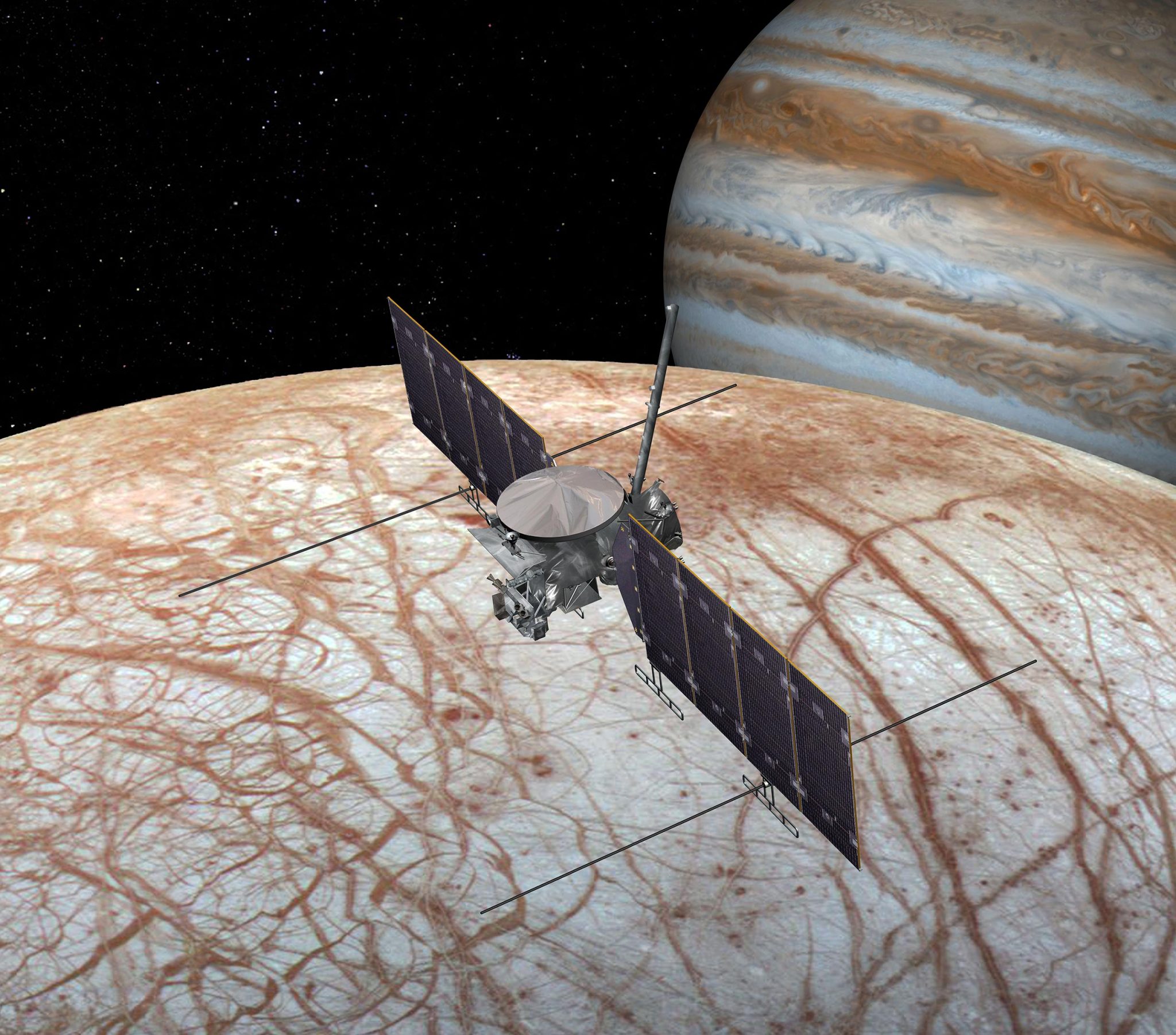Het ruimtevaartuig Europa Clipper zal de belangrijkste productiefaciliteit op[{” attribute=””>NASA’s Jet Propulsion Laboratory (JPL) as it prepares for its 2024 launch to Jupiter’s icy moon Europa.
The core of NASA’s Europa Clipper spacecraft has taken center stage in the Spacecraft Assembly Facility at JPL in Southern California. Standing 10 feet (3 meters) high and 5 feet (1.5 meters) wide, the craft’s main body will be the focus of attention in the facility’s ultra-hygienic High Bay 1 for the next two years as engineers and technicians assemble the spacecraft. It’s scheduled for launch to Jupiter’s moon Europa in October 2024.

Standing 10 feet (3 meters) high, the core of NASA’s Europa Clipper will be the focus of attention in High Bay 1 of JPL’s storied Spacecraft Assembly Facility, as engineers and technicians assemble the spacecraft for a 2024 launch. Credit: NASA/JPL-Caltech
Scientists believe the ice-enveloped moon harbors a vast internal ocean that may harbor conditions suitable for supporting life. During nearly 50 flybys of Europa, the spacecraft’s suite of science instruments will gather data on the moon’s atmosphere, surface, and interior. Scientists will use that information to gauge the depth and salinity of the ocean, the thickness of the ice crust, and potential plumes that may be venting subsurface water into space.

Engineers and technicians use a crane to lift the core of NASA’s Europa Clipper spacecraft in the High Bay 1 clean room of JPL’s Spacecraft Assembly Facility. Credit: NASA/JPL-Caltech
Several of Europa Clipper’s science instruments have already been completed and will be installed on the spacecraft at JPL. Most recently, the plasma-detection instrument, called the Plasma Instrument for Magnetic Sounding, and the Europa Imaging System wide-angle camera arrived from the Johns Hopkins Applied Physics Laboratory (APL), in Laurel, Maryland. Additionally, the thermal-emission imaging instrument, called E-THEMIS, and the ultraviolet spectrograph, Europa-UVS, have already been installed on the spacecraft’s nadir deck, which will support many of the instrument sensors by stabilizing them to ensure they are oriented correctly.

Engineers and technicians use a crane to position the core of NASA’s Europa Clipper spacecraft during a maneuver to position it in the High Bay 1 clean room of JPL’s Spacecraft Assembly Facility. Credit: NASA/JPL-Caltech
Fabricated at JPL, this key piece of hardware will soon move into the Spacecraft Assembly Facility’s High Bay 1. This is the same clean room where historic missions such as Galileo, Cassini, and all of NASA’s Mars rovers were built.
Also moving soon to High Bay 1 will be the aluminum electronics vault, which will be bolted to the main body of the spacecraft. It will protect the electronics inside from Jupiter’s intense radiation. The electronics enable Europa Clipper’s computer to communicate with the spacecraft’s antennae, science instruments, and the subsystems that will keep them alive.

Europa Clipper’s vault, with the nadir deck attached, is prepared for a move to the High Bay 1 clean room of the Spacecraft Assembly Facility at JPL. The vault will protect the spacecraft’s electronics, while the nadir deck will provide a stable platform for science instruments. Credit: NASA/JPL-Caltech
Bright copper cabling snakes around the orbiter’s aluminum core. It contains thousands of wires and connectors handcrafted at APL. If placed end to end, the cabling would stretch almost 2,100 feet (640 meters) – enough to wrap around a U.S. football field twice.
Inside the core are Europa Clipper’s two propulsion tanks. The fuel and oxidizer they’ll hold will flow to an array of 24 engines, where they will create a controlled chemical reaction to produce thrust in deep space.
Deze time-lapse-video volgt NASA’s Europa Clipper-ruimtevaartuig terwijl het zijn zorgvuldig gechoreografeerde verplaatsing maakt naar de High Bay 1 cleanroom in de Spacecraft Assembly Facility van het Jet Propulsion Laboratory. Krediet: NASA/JPL-Caltech
Tegen het einde van 2022 zullen naar verwachting de meeste vlieginstrumenten en de rest van de wetenschappelijke instrumenten voltooid zijn. Vervolgens zullen de volgende stappen een verscheidenheid aan tests zijn terwijl het ruimtevaartuig op weg is naar de lanceringsperiode van 2024. Na bijna zes jaar reizen en meer dan 2,9 miljard km (2,9 miljard km), zal het in 2030 een baan rond Jupiter bereiken.
Meer over de missie
Missies zoals Europa Clipper dragen bij op het gebied van astrobiologie. Dit is een interdisciplinair onderzoeksgebied dat de omstandigheden bestudeert van verre werelden die het leven zoals wij dat kennen zouden kunnen herbergen. Hoewel de Europa Clipper geen missie is om leven te detecteren, zal hij een gedetailleerde verkenning van Europa uitvoeren en onderzoeken of de ijzige maan, met zijn ondergrondse oceaan, het potentieel heeft om leven te ondersteunen. Inzicht in de bewoonbaarheid van Europa zal onderzoekers in staat stellen beter te begrijpen hoe het leven op aarde is geëvolueerd en de mogelijkheid om leven buiten onze planeet te vinden.
JPL, beheerd door het California Institute of Technology (Caltech) in Pasadena, Californië, leidt de ontwikkeling van de Europa Clipper-missie in samenwerking met APL voor NASA’s Science Mission Directorate in Washington. APL ontwierp het hoofdgedeelte van het ruimtevaartuig in samenwerking met JPL en NASA’s Goddard Space Flight Center in Greenbelt, Maryland. Het Planetary Missions Program Office in het Marshall Space Flight Center van NASA in Huntsville, Alabama, beheert het Europa Clipper-missieprogramma.







More Stories
China is van plan het Tiangong-ruimtestation uit te breiden; Stel deze in op “Space Rule” omdat het ISS wordt uitgeschakeld
De Verenigde Staten detecteren het eerste geval van de H5N1-vogelgriep bij een varken, wat aanleiding geeft tot bezorgdheid voor de mens
NASA zal in 2025 de ruimtewandelingen aan boord van het internationale ruimtestation hervatten na een lek in het ruimtepak